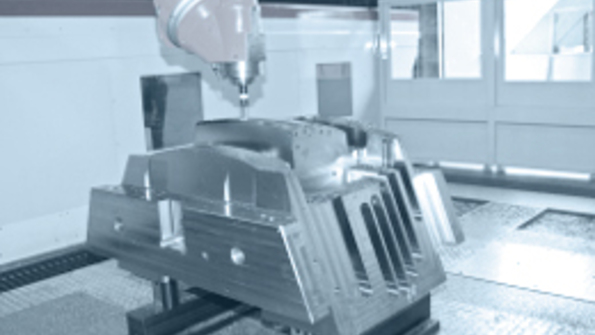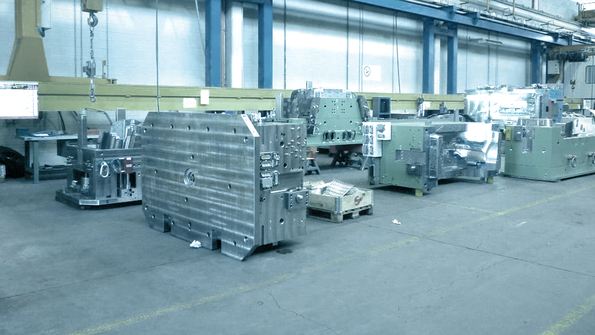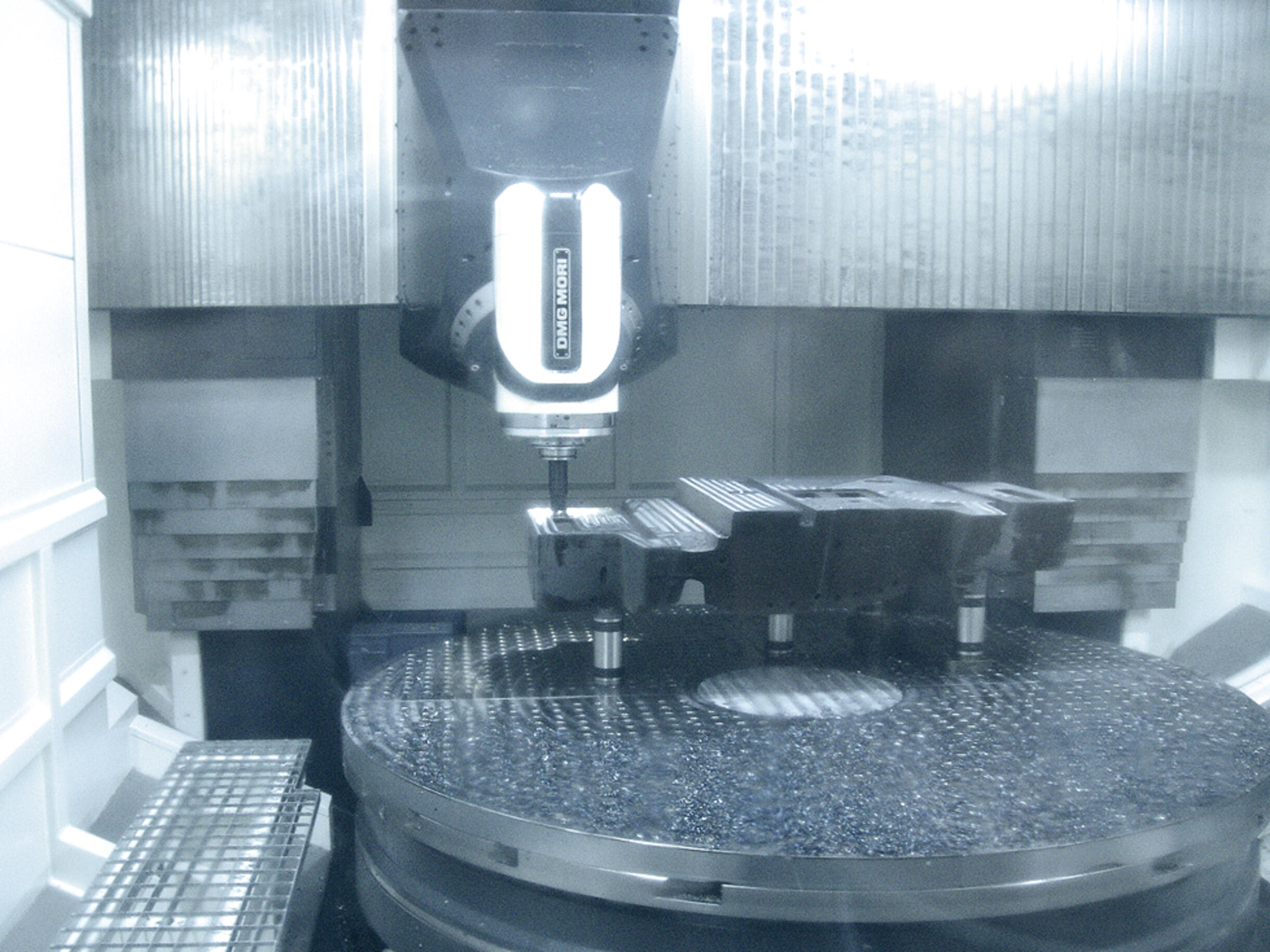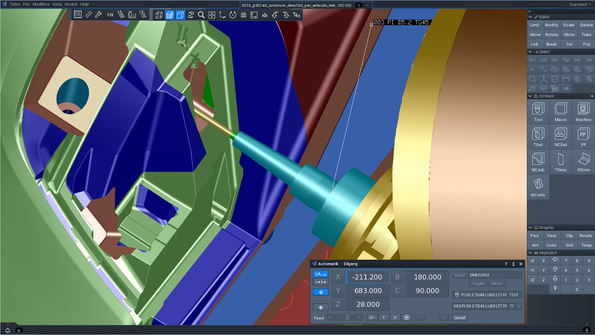Excellence as a deciding factor
Excellence as a deciding factorDie and mold manufacturer Sanvito & Somaschini is always looking for ways to improve its production process. In cooperation with Tebis, a targeted intervention was implemented to perfectly optimize and drive maximum production performance during the milling process. The company places great emphasis on quality, reliability and on-schedule processes.
Company
Sanvito & Somaschini S.p.A.
Location
Carate Brianza, Italy
Focus
Add-ons to Premium and Professional licenses for die and mold: Surface Design, 2.5D Drilling and Milling – plus, 5-sided machining, CAD data processing for CNC processes, Feature Technology - ruled form, programming with virtual machines, simultaneous calculation process, Collision Check - machine, Interfaces.
Benefits:
- Automation of the production process and implementation of unattended machining cycles
- Optimization of shop-floor processes using cutting-edge technology
- Ensuring machine safety through collision monitoring and virtual machine programming
Sector
Mold manufacturing
Published
2016

Interviewee: Ingenieur Salvatore Morreale, Plant manager
All production resources, from tools and machines to machining parameters and features—and even strategies—were developed using Tebis software. And they were also modeled within the software. This ensures high product quality.
A traditional company with a view to the future

Sanvito & Somaschini is a leading Italian company for die manufacturing and the production of specialized plastic parts for the automotive industry. The company was founded in 1968 by Alfredo Sanvito and Giuseppe Somaschini in Carate Brianza. Initially, the company produced small- to medium-sized dies for thermoplastic and thermosetting materials, primarily for the automotive industry. A second plant was opened in 1989 to manufacture medium- to large-sized molds. Sanvito & Somaschini currently has more than 160 employees, nearly twice as many as 10 years ago.
The original plant in Carate Brianza has over 25 milling machines and is responsible for roughing and semi-finishing smaller molds, as well as for the assembly and acceptance of dies for lamps. The core business, comprising engineering, assembly and acceptance of the medium- and large-sized molds, is conducted in the Renate plant, which is equipped with a 4,000- and 4,500-ton press. Production capacity in Renate was recently expanded by the addition of a 3,000-square-meter building: This can house up to nine large molds with a weight of up to 50 tons.
The company has built an outstanding reputation not only in the local market but also on an international level. Foreign customers are responsible for the majority of revenues: 70% is from Germany, 20% from France and 10% from the rest of the world.
Exact planning to the smallest detail

By focusing on the engineering and assembly sectors, the company is now capable of producing the entire range of plastic mold frames: from bumpers to the flank and from the rear spoiler to the front grille. But it can also produce highly complex headlights and lamps.
From initial calculation to acceptance, the Sanvito & Somaschini team requires roughly 18 weeks to produce a large mold. The same procedure required 24 weeks in the past. The reason for this time savings is the care with which the engineering department tests the workpiece in advance. Engineering also prepares the feasibility study and selects the most suitable production resources. "At the end of the process, both the matrix and the die must have especially high quality and arrive at the die manufacturer with absolutely no conformity errors. We have therefore completely transferred all of our die manufacturing capabilities to the engineering department," says Salvatore Morreale, engineer and plant manager. In the past, the company defined the mold and its movements and then attempted to design the mold directly during manufacturing. Now, a machining operation is not approved until all necessary data have been entered for accurate and defect-free fabrication of the workpiece.
Automation for the entire manufacturing
Right from the start, company management was continuously focused on quality and efficient production. This is why Sanvito & Somaschini decided to switch to Tebis Software about 20 years ago. Tebis also offered solutions that the company considered optimal to meet the growing demand for headlight production.
Collaboration between Tebis and Sanvito & Somischini soon expanded: In 2004, Alfredo Sanvito decided to automate the electrode design process and introduce a series of machines with unattended work cycles.
Therefore, he decided to buy the new Tebis simulation software. It has been an unrivaled success for the company: The automation introduced for the electrode machines was gradually expanded to include the entire shop. Thus, Sanvito today has exemplary efficiency, optimized processes, and the most advanced technology.
The milling departments in the Carate Brianza plants do not work with conventional machine centers, but rather with hi-speed milling machines—mostly palletized and with 5 continuous axes—as well as with EDM and deep-hole drilling machines.
"We only perform machining operations with a high degree of added value in the die department," says Morreale. "In contrast to the conventional manufacturing, of our machinery exactly corresponds to the machining operation we want to perform. In the office, we have the competence and CAD/CAM solutions to implement any milling process. We therefore can completely fulfill our customers’ requirements and resolve any difficulties well in advance."


The quality of the products that Tebis offers in the safety area was a determining factor for the decision at Sanvito & Somaschini. In 2013 and 2014, a CAD/CAM software competitor managed to introduce an alternative solution in the company. After 18 months of technical comparison tests, Sanvito & Somaschini dropped the competitor product because the management of collision checking and machine safety proved inadequate. Over the years, the CAM office has acquired a growing variety of Tebis software solutions, including machining with 2.5 as well as 3 and 5 axes, simulation modules, postprocessors, converters and interfaces. It now has a correspondingly wide range of operating instruments. The CAM office currently uses 17 floating licenses for machining molds: 15 Premium licenses (DMM3) and two recently acquired Professional licenses (DMM2). These are supplemented by many additional design add-ons (Surface Modeling - plus), manufacturing (Drilling and Milling 2.5D - plus, 5-sided machining) as well as manufacturing preparation (CAD data processing for CNC processes). The add-ons include CNC automation (standard feature design), CNC efficiency (virtual machine programming, simultaneous calculation process) as well as CNC safety (collision checking).
Improving profitability through process integration
A further benefit of Tebis is its integration of process and management in a single user interface. Structuring a comprehensive and stable process environment equipped to manage all machining cycles was key to improving company profitability. The possibility of structuring highly efficient and optimized processes was a determining factor: This protects the operating profit margin. "All production resources, from tools and machines to machining parameters and features—and even strategies—were developed using Tebis software. And they were also modeled within the software," explains Morreale. "This ensures high product quality."
Adaptive roughing is a Tebis innovation that was warmly received and immediately implemented in the company. This technology models the path layout without full cuts and automatically adapts it to the geometry of the components. The entire cut-depth of the tool is used here. This strategy can prove especially useful in the machining of components with steep cavities.
The Sanvito & Somaschini CAM office has a wide range of Tebis software solutions, allowing the die manufacturer to recently start implementing a new technology for composites. This uses compression molding instead of injection molding, opening up new and interesting perspectives for the company on the international market.


